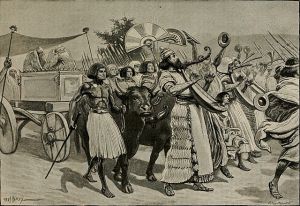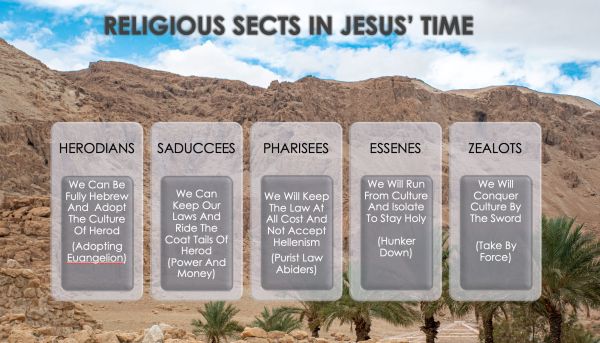People Groups of New Testament Israel
All cultures have people groups that define how society functions. The Jewish people throughout history are no different.
People groups also change over time as cultures redefine and reorganize themselves due to political, religious, and cultural realties. Understanding how these groups function helps us to gain clarity on paradigms, politics, and relationships of any particular chapter in the history of a culture.
In the case of the New Testament, understanding how these people groups are defined helps us gain clarity on the teaching of Jesus, the Apostles, and the early church.
People Groups of the New Testament and Jesus' Time
The teachings of Jesus and the writings of the New Testament authors primarily reference the people groups of the Jewish culture at the time of Christ. These people groups can give us clues about the political, economic, social, and religious relationships in play during Jesus' earthly life. Although, there are several groups that will not be discussed here, we will cover the primary classifications that will help us better understand the principles taught by Jesus in his teachings and parables.
This article will identify and briefly describe people groups based on three characteristics:
- Religious Order
- Political Order
- Economic Order
- Social Order
Because Jewish life is religious life, these characteristics intertwine among the groups. A person's religious status cannot be separated from his political, economic, and social status. That differs from people groupings in the modern west. One can have a social status that is independent of political status, or an economic status that is not affected by his religious status. However, in New Testament Jewish culture, these characteristics overlap and are often dependent on one another.
In addition to these social characteristics, we often find that the local region where a person lived impacted their status among society.
For example, Samaritans had a low place on the social hierarchy of the New Testament Jewish culture because of their political and religious history and DNA. And the agricultural people had less power and influence than those living in the larger cities.
See the article on Types of Cities in the New Testament for an explanation on the following types of villages, towns, and cities.
- Agros
- Kome
- Polis
- Techos
History of the Political and Religious Status of the New Testament
Here is a brief outline of the people groups of the New Testament. Click on any of these groups to learn more. For a history leading up to the New Testament click here.
Prior to the time of the New Testament, there was dramatic cultural shifts that began to divide the people of Israel into various cultural classes. The power of Hellenism that had invaded the Jewish people first with the Greeks and then with the Romans brought with it tremendous development in four areas:
- Education (hospitals)
- Athletics (arena)
- Entertainment (theater)
- Healthcare (hospitals)
Those four critical issues were promised by Hellenism as it made its way across the known world. The primary dividing line between the following six groups of people was drawn based on each groups desire to adopt Hellenistic culture.
As Alexander the Great began his conquest to conquer the world, his good news (euangelion) was heralded by his followers and became a rally cry for the march across the known world.
For the first time in the history of mankind, the gods were no longer the center of the universe. No longer was man made in the image of the gods, but the gods were made in the image of man. The great philosopher, Pythagorus, around 500 BC said, "Man is the measure of all things."
This is the western culture that we, as Americans, now live in as well. Popular taglines and marketing slogans are evidence that the modern western culture has adopted the message of Hellenism.
- I Did It My Way
- Have it Your Way
- We Did It our Way
The focus on the centrality of man helps us understand why Alexander's "Good News" was so compelling. Bow you knee to the ruler and he'll bring you great education, healthcare, entertainment, and competition. And you can prove yourself to be bigger than the gods.
Hellenistic culture is on display in the ten Greco-Roman cities called the Decapolis west of the Sea of Galilee. Their baths and theaters and arenas are spectacular displays of grandeur and wealth.
The Hellenists and the Sadducees were the groups that stayed focused on the polis and techos with all the trappings of the large cities. The Zealots and the Pharisees were committed to maintaining the Jewish Law, identity, and culture but moved north into the Galilee region to do so. The fifth group escaped the trappings of Hellenism altogether by moving to the desert and isolating themselves from culutre.
The Herodians
The most Greco-Roman committed group of Jews during the time of Christ was the Herodians.
As their name implies, they were supporters of the rule of Herod over Israel. They were also thrilled with all the conveniences and advantages that Hellenism brought to Israel. Although they maintained the identity of a Jew, they adopted everything that Hellenism brought to the region. They embraced the rule and control of Rome and committed to live peaceably under it as long as they got the benefits of Hellenism. What set them apart from the Sadducees was that they were not priests, but common Jews.
The Sadducees
The Sadducees also invited Greco-Roman wealth and prosperity into the Jewish culture. They maintained control of the Temple and controlled the Jewish people, but also wanted to partner with the Romans in a sort of survivalist mentality. They knew that if they could placate the Romans, there would be many benefits to their ruling of the Jewish people. They also leveraged the power of the Romans to get what they wanted - i.e. Jesus killed.
The Pharisees
Although we hear more about the Pharisees from Jesus and the New Testament than any other groups, they were ironically the most faithful to the Jewish Law and culture. Their hearts were to remain radically obedient to the Law and, therefore, preserve the culture of the Jews. The reason Jesus rejected them was due to their lack of compassion for real people. The Pharisees did hold one-half of the seats of the ruling council of the Sanhedrin, the real decision makers in the Jewish culture were the chief priests and rulers of the law. The Sanhedrin acted as more of a formal voting system of the people.
The Zealots
The Zealots were the offspring of groups like the Maccabees who leaned into physical force to gain power over the Hellenists. They were a radical group that left Judah to settle in Galilee and launch a guerrilla movement to take out the Roman government and even the Jewish elite by force. They used brutal tactics and harsh weapons to deliver damaging physical blows to anyone who was not faithful to traditional Judaism.
The Essenes
The Essenes were fully committed to stay faithful to the text of the Scriptures. So much so that they chose to isolate themselves from society and fully commit to living a pure Jewish life. They spent all of their time copying the scriptures and living obediently to the law. They left the cities and settled in caves next to the Dead Sea south of Judah. Their faithfulness gave us one of the greatest archeological finds in modern times - the Dead Sea Scrolls. They stayed faithful to their mission to their death by the Romans. They lived in a monastic community and most likely raised John the Baptist before he started his ministry of baptism.
Conclusion
Understanding these five groups of people helps us better understand the meaning of the scriptures and particularly the teachings of Jesus and other New Testament writers.




